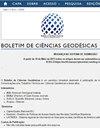圆形拟合改进GNSS定位通过智能手机为工程目的
IF 0.5
Q3 Earth and Planetary Sciences
引用次数: 0
摘要
通过访问某些Android智能手机收集的原始数据,可以对数据进行后处理。因此,可以采用以前仅限于大地测量接收器的某些卫星定位方法。由于这一点和其他创新,例如配备现代全球导航卫星系统传感器的智能手机的出现,在工程应用中使用这些设备是一个很有前景的场景。通常,在需要厘米和毫米级的高精度的某些应用中,使用大地测量接收器。然而,与智能手机相比,这些设备价格昂贵。在这项研究中,通过带有现代GNSS传感器的智能手机确定了一个点的坐标,IBGE-PPP服务使用GPS+GLONASS和L1频率组合对其数据进行后处理。因此,使用基于最小二乘的圆调整技术,可以分别在一组约128小时和24小时的会话中获得约12cm和25cm的水平精度。本研究的结果表明,该应用方法可用于工程中的某些应用,如农村土地调查。本文章由计算机程序翻译,如有差异,请以英文原文为准。
CIRCLE FITTING FOR IMPROVED GNSS POSITIONING VIA SMARTPHONES FOR ENGINEERING PURPOSES
With access to the raw data collected by certain Android smartphones, it is possible to perform post-processing of the data. Thus, it is possible to employ certain satellite positioning methods that were previously restricted to geodetic receivers. Thanks to this and other innovations, such as the emergence of smartphones with modern GNSS sensors, a promising scenario is seen when employing these devices in engineering applications. Generally, in certain applications that require high accuracy, centimeter and millimeter order, geodetic receivers are used. However, these devices are expensive when compared to smartphones. In this research, the coordinates of a point were determined via a smartphone with a modern GNSS sensor, whose data were post-processed by the IBGE-PPP service, using the combination GPS+GLONASS and L1 frequency. Thus, using circle adjustment techniques based on least squares, it was possible to obtain horizontal accuracy of approximately 12 cm and 25 cm with a set of about 128-hour and 24-hour sessions respectively. The results obtained in this research suggest that the applied methodology can be used in certain applications in engineering, such as land surveying of rural properties.
求助全文
通过发布文献求助,成功后即可免费获取论文全文。
去求助
来源期刊

Boletim De Ciencias Geodesicas
Earth and Planetary Sciences-General Earth and Planetary Sciences
CiteScore
1.70
自引率
20.00%
发文量
10
审稿时长
3 months
期刊介绍:
The Boletim de Ciências Geodésicas publishes original papers in the area of Geodetic Sciences and correlated ones (Geodesy, Photogrammetry and Remote Sensing, Cartography and Geographic Information Systems).
Submitted articles must be unpublished, and should not be under consideration for publication in any other journal. Previous publication of the paper in conference proceedings would not violate the originality requirements. Articles must be written preferably in English language.
 求助内容:
求助内容: 应助结果提醒方式:
应助结果提醒方式:


